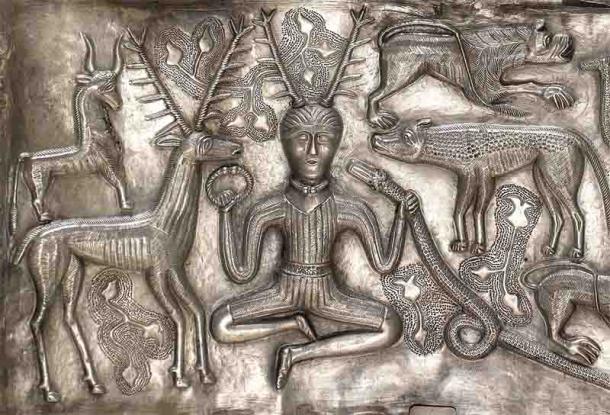Archaeologists in England have discovered an ancient humanoid figurine but they’re unsure whether it represents a god, or an everyday person. What do you think? The ancient humanoid figurine is finely detailed with a moustache, a short back and, possibly, a mullet hairstyle. Researchers say it offers a unique insight into the trends among native men in Roman-era Britain. However, what is not yet clear is whether this humanoid figurine depicts an ordinary man, or a divine being, as there are symbolic elements suggesting both possibilities.
The tiny 1st century AD humanoid figurine was unearthed in 2018 by archaeologists while they were pre-excavating a new car park at the Wimpole Estate, a country house located within the Parish of Wimpole, Cambridgeshire, England, about 8.5 miles (13.7 km) southwest of Cambridge.

The humanoid figurine as it was first found at the Wimpole Estate. (National Trust / Oxford Archaeology )
The Meaning Of The Humanoid Figurine Has Been Elusive
An article about the discovery published in The Guardian says the ancient male figure offers “a rare glimpse into ordinary Britons’ appearance,” or, into how they conceived their imagined gods.
Shannon Hogan, a UK National Trust archaeologist for east England, told the Guardian that the figure was “originally thought to be a Celtic deity .” However, now National Trust researchers believe it might simply be the face of “your average man.” They probably meant “common,” or “ordinary,” as “average” applies to math and not to any one person.
What Hogan probably meant was that the man was “human,” and not a deity of the ancient Celtic pantheon . She said there is a lack of both visual and written descriptions of what the native people of Britain looked like and what trends and styles were most popular at any given period in history. The researcher pointed out that the man’s neat haircut “appears to be a mullet,” which most media outlets are headlining with, but she was quick to add that the hairstyle might have been formed in the manufacturing process. However, reverting to the idea that the humanoid figurine depicts actual styles of the day, she added that the creator’s decision to omit a beard “was deliberate.”

The Celtic horned god of the woods, known as Cernunnos, is depicted here holding a torc in his right hand. (Nationalmuseet / CC BY-SA 3.0 )
Symbols Of The Elite? Or Of The Divine?
The big question in all this is whether the humanoid figurine depicts a Roman or Celtic man, or a Roman or Celtic god?
According to Chris Thatcher from Oxford Archaeology East “the figure offers a look into the aesthetics and symbolism of the age.” Thatcher speculated that the figure depicted someone “of influence and power” because he is holding “a torc.” This open-ended metal neck ring, sometimes gold and silver, was a status symbol in Celtic Britain.
In many depictions of the gods and goddesses of Celtic religion and mythology divine beings are either wearing or carrying a torc, which symbolizes their divinity. This is especially true in depictions of the horned god of the woods, “ Cernunnos,” who is often shown carrying a torc.
The collection of over 300 artifacts discovered at the Wimpole carpark site are revealing to archaeologists how the place might have functioned in Roman ruled Celtic Britain in the 1st Century AD.
Since the first artifacts were unearthed in 2018 it has been theorized that the site started out as a remote trading station and then, over time, grew to become the center of an established trading network.
And because such a rare and valuable figurine was discovered at the site, it stands as further evidence of the location having served both the Celtic and Roman populations as “a local hub.”
The archaeologists who unearthed the 300 objects at the site of the planned car park have forwarded their best guess as to what the humanoid figurine was made for. They told the Guardian that “it would have originally been connected to a spatula used for mixing medicines or wiping the wax tablets that were used for writing.”
Top image: The front and back of the cleaned humanoid figurine found in 2018 in Wimpole. Source: National Trust / Oxford Archaeology
By Ashley Cowie
 RSS Feed
RSS Feed















 February 22nd, 2021
February 22nd, 2021  Awake Goy
Awake Goy  Posted in
Posted in  Tags:
Tags: 













